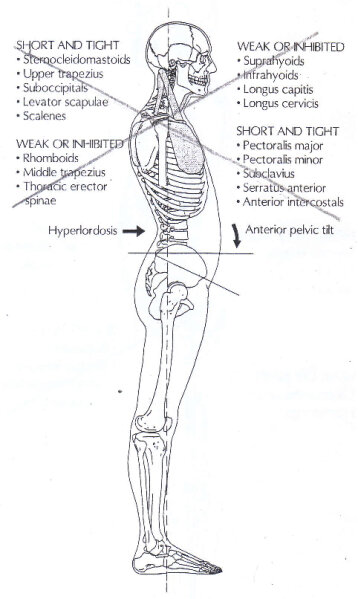Postural vs Phasic Muscles
When considering muscular imbalances in the body, it’s important to remember that some muscles are mechanically predisposed to being short and tight, while others are prone to being weak and inhibited. It’s no coincidence then that most people complain of neck and shoulder tension, while you never hear anyone say, “my abs are feeling too tight…” For this reasons, muscles tend to fall under two main categories: postural and phasic.
Postural muscles by their very nature are designed to keep us balanced and upright. A perfect example of this is the paraspinal muscles. These long, mound-shaped muscles on either side of the spine have to work continuously to keep the spine erect. These muscles are built for endurance and have a high threshold for sustained contraction and fatigue. But like everything else, they have their limit and can easily fall victim to over use.
Phasic muscles on the other hand were designed primarily for movement. The glutes for example, help to extend the hip and leg when we’re walking. So if we lead a fairly sedentary life, these muscles can easily become weakened and atrophy. Phasic muscles are easily fatigued and don’t have the endurance that postural muscles have. To understand why this is, we have to consider something known as “fast-twitch, type II muscle fibers” and “slow twitch, type I muscle fibers.”
Phasic muscles contain a high density of fast-twitch muscle fibers. They rely primarily on anaerobic metabolism to fuel their contraction and for that reason, can easily be fatigued. Anaerobic simply means, without oxygen. So whenever these muscle fibers are recruited, they’re relying primarily on a metabolic process that does not use oxygen, such as the body’s glycogen stores. As a result they produce waste by-products, which can impair muscle contraction, which in turn leads to fatigue. Fast-twitch muscle fibers are usually involved in rapid and intense movements of short duration. Think of weight lifting, throwing a ball, or sprinting.
Postural muscles are imbued mostly with slow-twitch muscles fibers. These slow-twitch fibers rely on aerobic or oxygen-based metabolism and have a high threshold for fatigue. Low to moderate intensity activities such as walking or jogging rely heavily on the aerobic nature of these slow-twitch muscle fibers. Any activities involving endurance, whether it be walking or running a marathon, require oxygen as fuel. This is why we become fatigued even during low to moderate activities done over a prolonged period of time. As oxygen stores become depleted during our workouts, we start relying more on anaerobic metabolism as a fuel source.
There’s a third type of fast-twitch muscle fiber that uses oxygen as a fuel source and is resistant to fatigue, much like the slow twitch muscle fibers described above. To distinguish between these two very different types of fast-twitch muscle fibers, they’re often referred to as “fast oxidate, type IIA” and “fast glycolytic, type IIB” – which is described above. In the order of recruitment, these fast oxidate, type IIA muscle fibers are often called upon last to do their job (the first being the slow twitch type I, and the second being the fast glycolytic type IIB). Another distinction worth noting amongst these different types of muscle fibers is their color. The slow- twitch, type I are rich in oxygen and are therefore red in color. The fast-twitch, type IIA are red to pink. And the fast-twitch, type IIB are white/pale due to their low oxygen stores.
Imbalances between postural and phasic muscles can become pronounced leading to a condition known as “upper crossed syndrome” — when it involves the upper body, and “lowered crossed syndrome” — when it involves the lower body. These syndromes are a result of short and tight muscles going unchecked by their weak and inhibited counterparts. In the case of lower crossed syndrome, we have an exaggerated forward tilt of the lumbar spine, something known as a hyperlordosis, created by tight lower back muscles (erector spinae & quadratus lumborum), in addition to tight hip flexor and adductor muscles (iliopsoas, rectus femoris, tensor fasciae latae, adductors). The weakened abdominals, glutes and hamstrings are no match for these strong postural muscles. To bring balance here, one would have to focus on strengthening the weakened muscles and stretching the tightened muscles.
Below is a list of key postural and phasic muscles:
Postural Muscles (prone to tightness):
Gastrocnemius, Soleus, Tibialis Posterior (lower leg)
Hamstrings, Rectus Femoris (upper leg)
Iliopsoas, Tensor Fasciae Latae, Piriformis (hip)
Erector Spinae (cervical & lumbar), Quadratus Lumborum (lower back)
Upper Traps, Levator Scapulae, Sternocleidomastoid, Scalenes, Suboccipitals (upper back and neck)
Pectoralis Major (chest)
Flexors of the upper limb (i.e. Biceps)
Phasic Muscles (prone to weakness):
Peroneals, Tibialis Anterior (lower leg)
Vastus Medialis, Intermedius & Lateralis (upper leg)
Gluteus Maximus, Medius & Minimus (hip)
Rectus Abdominus (mid-section)
Serratus Anterior, Rhomboids, Lower Traps (shoulder & upper back)
Short cervical flexors (i.e. Longus Capitis & Longus Cervicis)
Extensors of the upper limb (i.e. Triceps)


